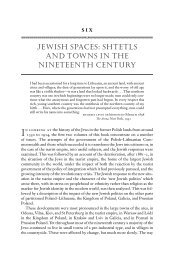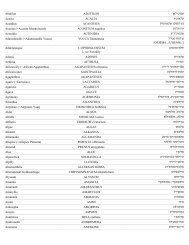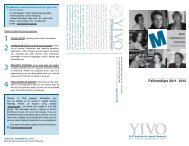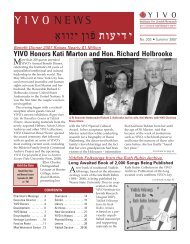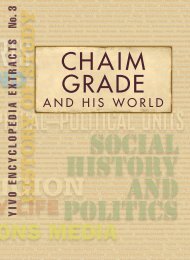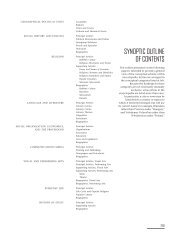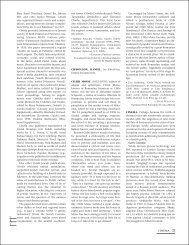Here - YIVO Institute for Jewish Research
Here - YIVO Institute for Jewish Research
Here - YIVO Institute for Jewish Research
Create successful ePaper yourself
Turn your PDF publications into a flip-book with our unique Google optimized e-Paper software.
eadily apparent when the American travelers appear oncamera, whether embracing and frolicking with locals orpraying and weeping beside the graves of their ancestors.As still photos documenting these trips also demonstrate,Americans presented themselves to the photographerdifferently than did Polish Jews, who generally appearless at home be<strong>for</strong>e the movie camera—an instrumentwielded by persons, once familiar as relatives or neighbors,who have been trans<strong>for</strong>med by their Americanness,the change evident on screen in their dress andcomportment.These films thus conjoined an innovative medium witha novel social phenomenon—the visit to Poland fromAmerica. The camera became a vector <strong>for</strong> tracing a newkind of connection between immigrants and their <strong>for</strong>mercommunities. While the visitors’ gaze is more obviously retrospective—beholdingthe world of their childhood—it alsoconsiders the prospects of their fellow Jews in Poland. Thistension is especially apparent in the films made to help infundraising. For example, a 1935 film screened at a banquetof the Sędziszów landsmanshaft opens with an exhortationto the immigrant <strong>Jewish</strong> audience in New York to reflect ontheir hometown’s past and, implicitly, to consider its future:“Sędziszów, as we knew it, has vanished. Its remains struggles[sic] desperately <strong>for</strong> life amidst suffering and starvation,with only little relief in sight. The scenes following depictpart of miserable conditions prevailing. Reminiscences of ouryouth will now take us back to the very cradle of our birth. Itssons and daughters, who have here attained high positionsin social and commercial life and achieved financial success,have trodden the paths of this now desolated community. “Indeed, all these films leave unanswered the question—asked, perhaps tacitly, by both Polish Jews and theirimmigrant visitors: When will we see one another again?This question may have been voiced not only when thesetravel films were shot but again when they were screened.Like home movies generally, especially those recordedwithout sound, they would have been accompaniedby commentary when shown to family and friends. Ineffect, this live, impromptu chatter completed the films,not only identifying the people and places depicted butalso offering expansive narratives that link the images ofthe visit to decades of memories extending beyond whatappears on screen.After World War II, this footage has acquired a profoundlydifferent symbolic value, one scarcely imaginedby either the filmmakers or their subjects in the 1920sand 30s. Prized even more than still photographs of interwarPolish Jewry, given these films’ relative scarcity and



